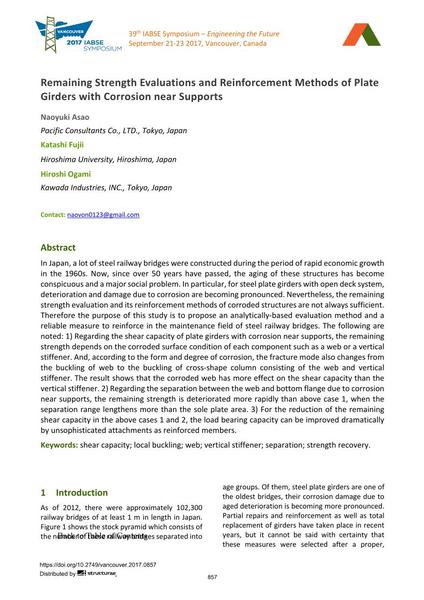Remaining Strength Evaluations and Reinforcement Methods of Plate Girders with Corrosion near Supports

|
|
|||||||||||
Bibliographic Details
| Author(s): |
Naoyuki Asao
(Pacific Consultants Co., LTD., Tokyo, Japan)
Katashi Fujii (Hiroshima University, Hiroshima, Japan) Hiroshi Ogami (Kawada Industries, INC., Tokyo, Japan) |
||||
|---|---|---|---|---|---|
| Medium: | conference paper | ||||
| Language(s): | English | ||||
| Conference: | IABSE Symposium: Engineering the Future, Vancouver, Canada, 21-23 September 2017 | ||||
| Published in: | IABSE Symposium Vancouver 2017 | ||||
|
|||||
| Page(s): | 857-864 | ||||
| Total no. of pages: | 8 | ||||
| Year: | 2017 | ||||
| DOI: | 10.2749/vancouver.2017.0857 | ||||
| Abstract: |
In Japan, a lot of steel railway bridges were constructed during the period of rapid economic growth in the 1960s. Now, since over 50 years have passed, the aging of these structures has become conspicuous and a major social problem. In particular, for steel plate girders with open deck system, deterioration and damage due to corrosion are becoming pronounced. Nevertheless, the remaining strength evaluation and its reinforcement methods of corroded structures are not always sufficient. Therefore the purpose of this study is to propose an analytically-based evaluation method and a reliable measure to reinforce in the maintenance field of steel railway bridges. The following are noted: 1) Regarding the shear capacity of plate girders with corrosion near supports, the remaining strength depends on the corroded surface condition of each component such as a web or a vertical stiffener. And, according to the form and degree of corrosion, the fracture mode also changes from the buckling of web to the buckling of cross-shape column consisting of the web and vertical stiffener. The result shows that the corroded web has more effect on the shear capacity than the vertical stiffener. 2) Regarding the separation between the web and bottom flange due to corrosion near supports, the remaining strength is deteriorated more rapidly than above case 1, when the separation range lengthens more than the sole plate area. 3) For the reduction of the remaining shear capacity in the above cases 1 and 2, the load bearing capacity can be improved dramatically by unsophisticated attachments as reinforced members. |
||||
| Keywords: |
shear capacity local buckling web vertical stiffener separation strength recovery
|
||||
